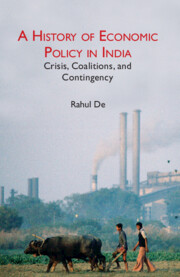Book contents
- Frontmatter
- Contents
- List of Figures and Tables
- Preface
- Acknowledgments
- List of Abbreviations
- Introduction
- 1 Colonialism and the Indian Economy
- 2 The Drive to Industrialize under Nehru's Leadership: 1950–66
- 3 The Turn to Populism under Indira Gandhi: 1967–79
- 4 The Early Liberalization Years: 1980–2003
- 5 Maturity of Reforms in the UPA Years: 2004–13
- 6 Reforms under the NDA Government: 2014–19
- Index
6 - Reforms under the NDA Government: 2014–19
Published online by Cambridge University Press: 14 September 2023
- Frontmatter
- Contents
- List of Figures and Tables
- Preface
- Acknowledgments
- List of Abbreviations
- Introduction
- 1 Colonialism and the Indian Economy
- 2 The Drive to Industrialize under Nehru's Leadership: 1950–66
- 3 The Turn to Populism under Indira Gandhi: 1967–79
- 4 The Early Liberalization Years: 1980–2003
- 5 Maturity of Reforms in the UPA Years: 2004–13
- 6 Reforms under the NDA Government: 2014–19
- Index
Summary
In 2014, a resurgent NDA government under the prime ministership of Narendra Modi came to power. Neither was India going through an economic, political, or international crisis nor was there a substantial change in economic policy marked by this period. However, the period was significant due to the historic domination of the BJP. This final chapter is different from the previous chapters: the logic of periodization in previous chapters of crisis and change does not explain this one. The reason for including the NDA in a separate chapter was because its politics were in stark contrast to the INC, and I wanted to explore whether they had a different philosophy or ideology for economic reforms and welfare policies than the INC. At the time of writing this chapter, the BJP has entered its second tenure as the central government on the back of a successful election campaign. I have decided not to write about the second NDA government, as it is difficult to analyze contemporary events with objectivity, especially in the aftermath of the COVID-19 lockdown crisis.
How did the BJP come to power when there was no historical precedence of a non-INC party getting majority votes (the NDA government of 1998 was a coalition government)? Political analysts credited the BJP's victory based on their political ideologies referred to as Hindutva politics (Sharma 2003; Madhav 2021; Ananthamurthy 2016). While Hindu nationalism or Hindutva politics is perceived as the main identity of the BJP's voters, this does not completely explain how they dominated elections in 2013–14. I take recourse to Nalin Mehta's (2022) comprehensive analysis of electoral data to explain the BJP's electoral success, which, as Mehta has argued, cannot be simplified as Hindutva politics. His counterfactual for this was that much of the BJP's Hindutva politics based around the Ayodhya movement and L. K. Advani's Rath Yatra were in the 1990s. However, even at the peak of Hindutva popularity, the BJP lost the 2003–04 elections. What explains their return in 2014? Mehta empirically demonstrates that a key part of the BJP's victory was based on its ability to capture electoral seats in Uttar Pradesh – the biggest constituency in India. It did so by changing the caste composition of its party and leveraging the use of digital technology in its campaign.
- Type
- Chapter
- Information
- A History of Economic Policy in IndiaCrisis, Coalitions, and Contingency, pp. 151 - 172Publisher: Cambridge University PressPrint publication year: 2024



